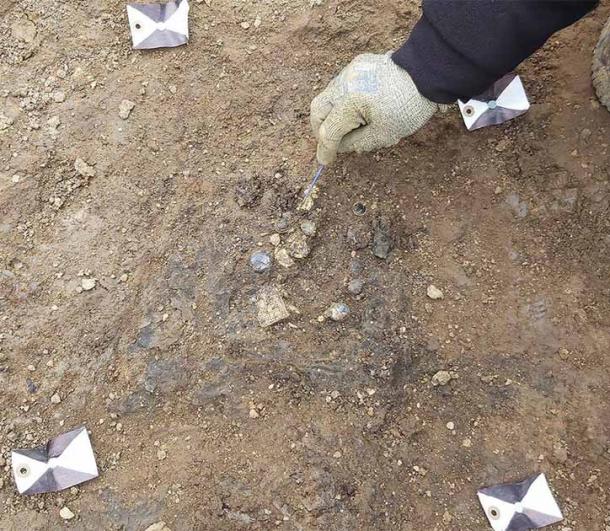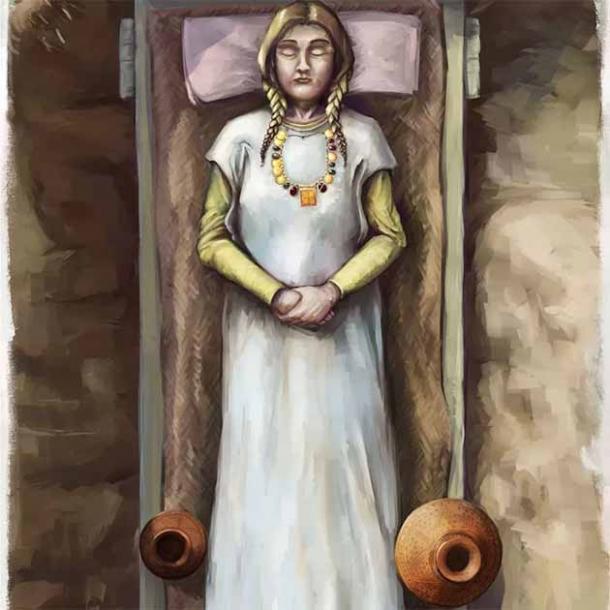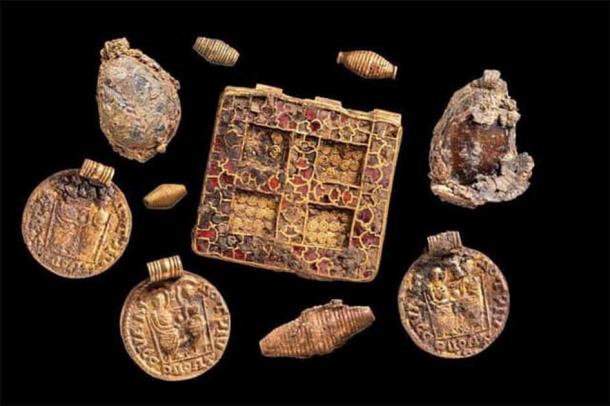A 1,300-year-old gold and gemstone necklace discovered in central England’s Northampton in the grave of an elite woman has been hailed as of ‘international importance’. Not just gold, but garnets and Roman coins both adorn the necklace, described as a ‘most significant’ find, with the entire assemblage of grave goods together called ‘The Harpole Treasure’, with no other necklace from the same period as elaborate as this one ever found in England.
Along with these, two decorated pots from either France or Belgium and a shallow copper dish have also been found. The clay pots contained an unidentified residue of an unknown liquid, which scientists are going to put the test soon.

The necklace in situ being carefully extracted by archaeologists. (Hugh Gatt/ MOLA)
Most Significant Early Medieval Female Burial in England Ever?
“When the first glints of gold started to emerge from the soil we knew this was something significant. However, we didn’t quite realise how special this was going to be,” said MOLA Site Supervisor Levente-Bence Balázs. “This is the most significant early medieval female burial ever discovered in Britain. It is an archaeologist’s dream to find something like this.”
The discovery had been made by archaeologists from the Museum of London Archaeology (MOLA), who had been supported by Archaeological Consultants, RPS, ahead of a planned upcoming housing development project. As per a report by The Guardian , this is likely the richest necklace of its type ever discovered in Britain, with unparalleled craftsmanship.
The burial likely took place between 630 and 670 AD, a time close to the graves of other high ranking women found around Britain. Perhaps this was a period of change and growth of women’s power and importance breaching the sphere of the private and becoming a mainstay in the public.

An artist’s impression shows what the grave of the high-status woman may have looked like. ( MOLA)
An Early Christian or Pagan Leader of Note
What makes it even more interesting is that this woman was likely an early Christian religious leader in Britain. At this moment in history, Christianity was battling with paganism for the people’s allegiance, though no ancient churches near the dig or other burial sites were found. What is also exciting, yet confusing, is that the uncovered items have a distinctly pagan tinge to them, but the grave goods are heavily vested with Christian iconography.
“Burying people with lots and lots of bling is a pagan notion, but this is obviously heavily vested in Christian iconography, so it’s that period of quite rapid change,” said Simon Mortimer of archaeological consultants RPS , who worked on the project.
Back in April, when the Vistry Group developers made this discovery under Balázs’ tutelage, it was just a glint in the dirt that caught his eye. Further examination showed that it was a rectangular gold pendant with garnets, reported MOLA. The centrepiece of the necklace also contained pendants that had been carved from golden Roman coins and semi-precious oval stones.

A collection of some of the pendants that adorned the luxurious necklace. (Hugh Gatt/ MOLA)
A large and ornate silver cross was placed on her body, with tiny well-preserved likeness of human heads with blue glass eyes. These were perhaps representations of Christ’s apostles, though that is only conjecture at this point.
All that remains of this woman are her tooth enamel crowns, and the knowledge that she had great personal wealth. Perhaps she was an abbess or a princess, or potentially both, but what the experts have agreed on is that she was one of the first women in English history to reach a high position in the male-dominated church. Lyn Blackmore, Museum of London Archaeology team specialist quipped that, “Women have been found buried alongside swords, but men have never been found buried alongside necklaces.”
In any case, this likely seems to be the most significant Anglo-Saxon find since the 7th century ship found at Sutton-Hoo. It will help piece together some gaps that exist in the prevailing knowledge of the area and the era, in roughly the time period between the departure of Britain’s Roman occupiers and the arrival of Viking raiders almost 400 years later.
“This is a find of international importance. This discovery has nudged the course of history, and the impact will get stronger as we investigate this find more deeply. These mysterious discoveries pose so many more questions than they answer. There’s so much still to discover about what we’ve found and what it means,” concluded Balázs. They now plan to display the finds in a local museum at the earliest time possible.
Top image: The Medieval treasure included this opulent necklace with gems from across Europe. Source: Hugh Gatt/ MOLA
By Sahir Pandey
Related posts:
Views: 0
 RSS Feed
RSS Feed

















 December 7th, 2022
December 7th, 2022  Awake Goy
Awake Goy  Posted in
Posted in  Tags:
Tags: 
















